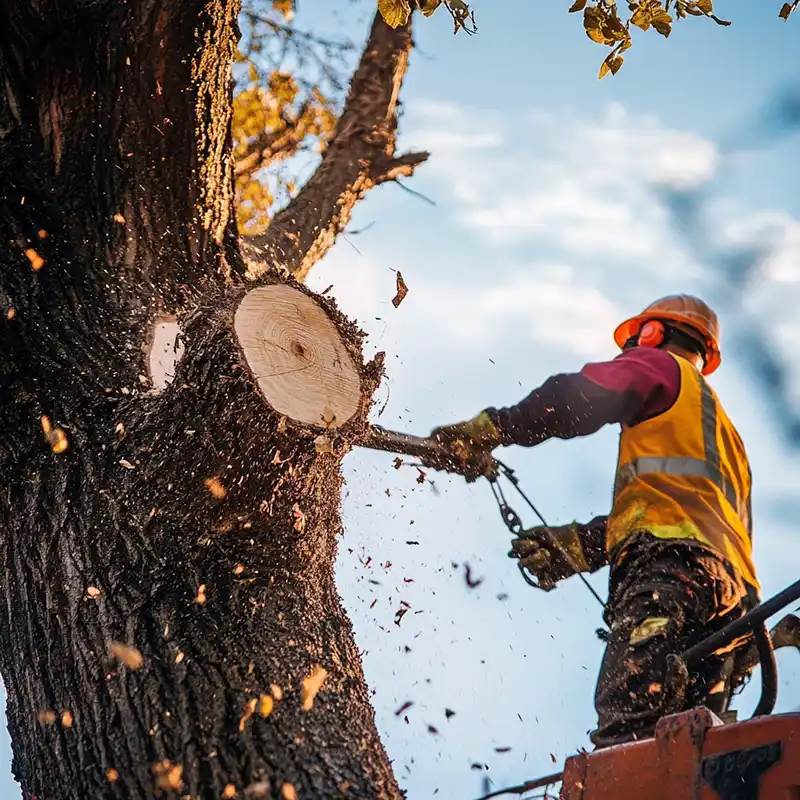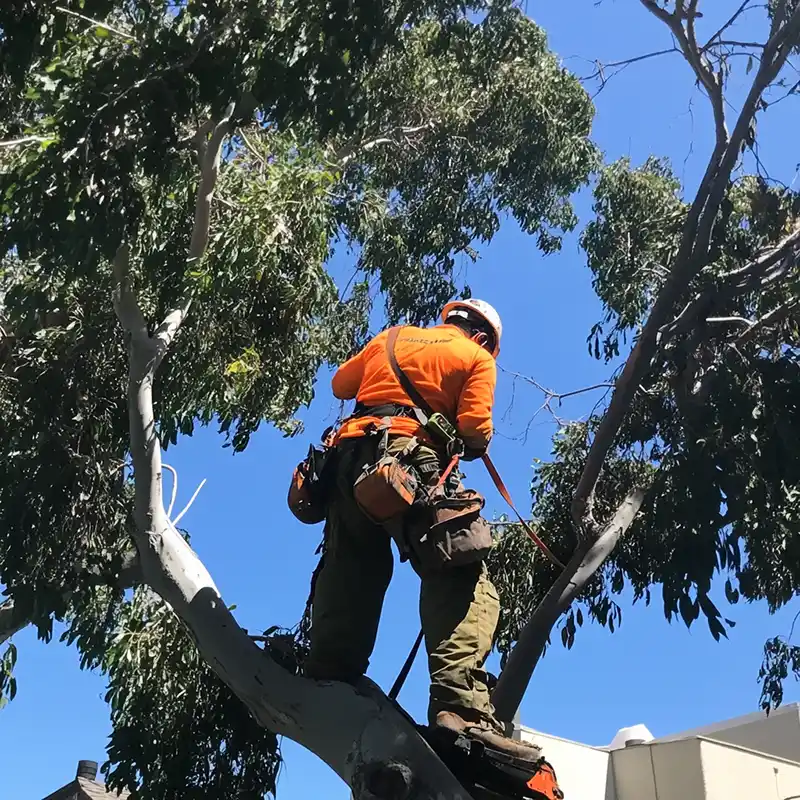Tree removal is a complex task that involves various factors, each influencing the overall duration. Understanding these factors can help you estimate the time required for your specific project.
How Long Does Tree Removal Take?
The average tree removal time can vary significantly depending on several factors, including:
- Tree size: Larger trees naturally take longer to remove.
- Accessibility: Trees in confined spaces or near structures may require additional precautions, increasing the time.
- Tree health: Dead or diseased trees might be removed more quickly than healthy ones.
- Location: Trees in urban areas often have more obstacles to navigate, extending the process.
- Removal method: The chosen method, such as felling, climbing, or aerial lifting, impacts the duration.
- Weather conditions: Adverse weather can delay or prevent tree removal.
Typically, a small tree can be removed in a few hours, while a large, complex tree might take several days.
Duration of Tree Removal: A Breakdown
The tree removal process can be divided into several stages, each contributing to the overall time:
Assessment:
Initial evaluation of the tree, its surroundings, and potential hazards. (15-30 minutes)
Preparation:
Clearing the area, setting up safety measures, and obtaining necessary permits. (30 minutes – 1 hour)
Felling:
Carefully cutting down the tree, ensuring it falls safely. (30 minutes – several hours)
Limbing and Topping:
Removing branches and limbs. (1-2 hours)
Grinding:
Use a wood chipper to reduce the debris into smaller pieces. (30 minutes – several hours)
Cleanup:
Removing any remaining debris and restoring the site. (30 minutes – 1 hour)
Tree Removal Process Time: Factors to Consider
Several factors can influence the duration of each stage:
Tree size and shape:
Larger, more complex trees will take longer to fall, limb, and grind.
Location:
Trees in confined spaces or near structures may require additional precautions, extending the time.
Weather conditions:
Adverse weather can delay or prevent tree removal.
Removal method:
The chosen method, such as felling, climbing, or aerial lifting, impacts the duration.
Time Required for Tree Removal: A General Timeline
While it’s difficult to provide an exact timeline without a specific project, here’s a general breakdown:
- Small tree: 2-4 hours
- Medium tree: 4-8 hours
- Large tree: 8-16 hours or more
- Very large or complex tree: Several days
Tree Removal Project Length: Case Studies
To illustrate how factors can influence tree removal time, let’s consider two case studies:
Case 1: Quick Removal
- A small, dead tree in an open field.
- Favorable weather conditions.
- No nearby structures or obstacles.
- Estimated time: 2-3 hours.
Case 2: Lengthy Removal
- A large, healthy tree in a densely populated urban area.
- Nearby structures and power lines.
- Adverse weather conditions.
- Estimated time: Several days.
Tree Cutting Time: A Crucial Factor
Tree felling, or cutting down the tree, is often the most time-consuming part of the process. Factors such as tree size, shape, and location play a crucial role in determining the time required.
Tree Removal Job Duration: Planning and Preparation
Proper planning and preparation can help minimize the duration of a tree removal project. This includes:
Choosing the right contractor:
A qualified and experienced contractor can efficiently complete the job.
Scheduling the removal:
Consider factors such as weather conditions and potential disruptions.
Preparing the site:
Clear the area around the tree to ensure safe access.
Average Tree Removal Time: A Range
The average tree removal time can vary widely, but a general estimate is between 4-8 hours for a medium-sized tree. However, as we’ve seen, factors such as tree size, location, and removal method can significantly impact the duration.
Time to Cut Down a Tree: Factors Affecting Speed
Several factors can influence the time it takes to cut down a tree:
- Tree size: Larger trees naturally take longer to fall.
- Tree health: Dead or diseased trees might be removed more quickly than healthy ones.
- Location: Trees in confined spaces or near structures may require additional precautions, increasing the time.
- Weather conditions: Adverse weather can delay or prevent tree removal.
Tree Felling Duration: A Skillful Task
Tree felling is a skilled task that requires precision and experience. A qualified arborist can safely and efficiently cut down a tree, minimizing the time required.
How Long to Remove a Tree: A Summary
The duration of tree removal can vary significantly depending on several factors. By understanding these factors and working with a qualified contractor, you can estimate the time required for your specific project and plan accordingly.
Tree Removal Efficiency: Tips for a Faster Process
To improve tree removal efficiency, consider the following tips:
- Choose the right removal method: Select a method that is suitable for the tree and its surroundings.
- Use advanced equipment: Modern tools and techniques can expedite the process.
- Work with experienced professionals: A skilled arborist can complete the job efficiently and safely.
- Plan: Proper planning and preparation can minimize delays.
Tree Removal Service Time: Factors to Consider
When choosing a tree removal service, consider the following factors:
- Experience and qualifications: Ensure the company has a proven track record.
- Insurance and licensing: Verify that they are properly insured and licensed.
- Estimates and Pricing: Obtain detailed estimates and compare prices.
- Customer reviews: Read reviews from previous customers.
Tree Cutting Duration: A Matter of Skill
The duration of tree cutting depends on the skill and experience of the arborist. A qualified professional can complete the task efficiently and safely.
Tree Removal Speed: Balancing Safety and Efficiency
While speed is important, it should not compromise safety. A qualified contractor can balance efficiency with safety to ensure a successful project.
Tree Removal Work Hours: Planning for Disruptions
Tree removal work can be noisy and disruptive. Plan the project accordingly to minimize inconvenience to neighbors.
Tree Removal Timeframe: Scheduling and Planning
A well-planned tree removal project can help ensure that the work is completed on time. Consider factors such as weather conditions and potential disruptions when scheduling the job.
Tree Removal Scheduling: Factors to Consider
When scheduling tree removal, consider the following factors:
- Weather conditions: Avoid scheduling during adverse weather.
- Nearby events: Avoid scheduling during times when noise and disruption could be problematic.
- Tree health: If the tree is a hazard, it may need to be removed immediately.
Tree Removal Completion Time: Factors Affecting Duration
Several factors can affect the completion time of a tree removal project, including:
- Tree size and complexity: Larger, more complex trees will take longer.
- Weather conditions: Adverse weather can delay the project.
- Access to the site: Difficult access can increase the time required.
- Unexpected obstacles: Unforeseen issues can prolong the project.
Tree Removal Start to Finish
From initial assessment to final cleanup, the tree removal process involves several stages. By understanding each stage and its potential duration, you can better estimate the overall time required for your project.
Factors Affecting Tree Removal Time
In conclusion, the duration of tree removal is influenced by various factors, including tree size, location, health, removal method, and weather conditions. By understanding these factors and working with a qualified contractor, you can estimate the time required for your specific project and plan accordingly.



